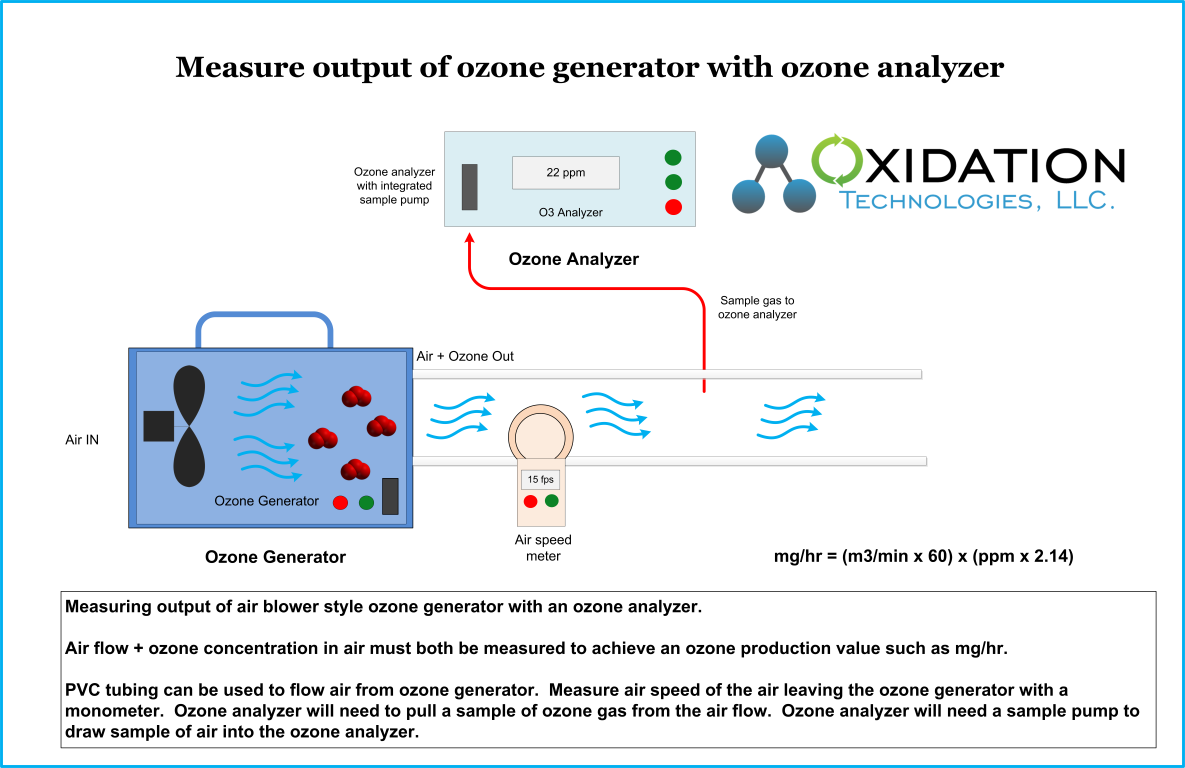Test ozone output from commercial ozone generator
Commercial (air blower style) Ozone Generator:
Some ozone generators produce ozone directly from ambient air by blowing air past a corona discharge dielectric or UV light. These ozone generators are used for air treatment, odor removal, or mold restoration applications. This article will refer to these ozone generators are Commercial Ozone Generators.
Ozone production from these commercial ozone generators is almost always measured in mg/hr. Therefore we will use only this unit of measure for ozone production calculations.
To determine the mg/hr of ozone from an ozone generator we must determine the milligrams of ozone that are produced in a given hour period of time. This is done by determining the air flow-rate through the ozone generator and the concentration of ozone in that gas.
Concentration of ozone is normally measured in ppm for these ozone generators due to the relatively low concentration of ozone and overall accuracy of devices available.
Equipment required:
-Monometer
-Flow Tube
An ozone meter will be required to measure ozone concentration in the air leaving the ozone generator. This must have a sample pump to draw a sample of gas from your flow tube into the monitoring device. This will provide the most accurate ozone measurements without disrupting your air flow. Ideally a UV based ozone analzyer will be used to measure ozone levels due the greater precision and accuracy available. However, there are some ozone meters available using electrochemical or HMOS sensor cells that can pull a gas sample into the sensor and provide reasonable accuracy. For the best accuracy in ozone production choose the most accurate ozone meter possible.
The specific ozone analyzer we recommend to use for this testing is the UV-100 Ozone Analyzer. This is available for sale, or for rent for shorter term needs.
A Monometer is used to measure airflow by measuring the velocity of airflow in your flow tube. A digital monometer can be obtained that will measure airflow in a variety of units of measure. For the best accuracy in ozone production choose the most accurate monometer possible.
A Flow Tube must be constructed to measure airflow from the ozone generator. This tube can be constructed of PVC or other plastic materials. The airflow from the ozone generator must have as much turbulence removed as possible to accurately measure air speed. This tube must be sealed directly to the outlet of the ozone generator and must not restrict air flow in any way. Actual air flow of the ozone generator in normal operation must be obtained and measured accurately.
The illustration below provides an example of how this equipment can be set-up to measure the output of a commercial ozone generator:
Units of Measure:
For more information on common ozone-related units of measure click HERE.
mg/hr = grams per hour – commonly used to measure the output of commercial ozone generator. 1 mg/hr = 1,000 mg/hr ozone
ppm = parts per million – commonly used to measure ozone concentrations in ambient air. Can be measured by weight or by volume, most commonly is measured by volume, for the purpose of this article, we are using only ppm by volume.
m3/min = cubic meters per minute = measurement of air flow from ozone generator
m/s = meters per second= measurement of air speed, monometer will measure air speed in m/s
Calcuations:
Ozone production calculation:
mg/hr = (m3/min x 60) x (ppm x 2.14)
Example:
- 100 mm x 100 mm square flow tube (100 mm is about 4”)
- 10 ppm ozone concentration
- 5 m/s air speed in flow tube (5 m/s = 16.4 ft/s)
100 mm = 0.1 meters
0.1 x 0.1 = 0.01 m2
0.01 m2 x 5 = .05 m3/second
.05 x 60 = 3 m3/min
(3 m3/min x 60) x (10 x 2.14) = 3,852 mg/hr ozone production
Click image below for online calculator for each of the conversions and calculations listed here












